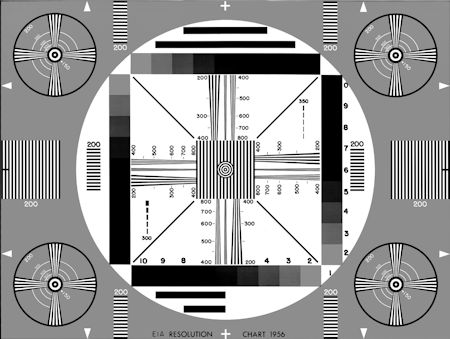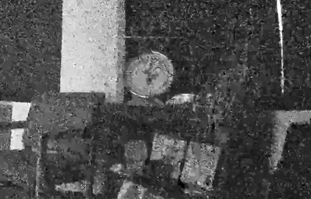
Resolution is a critical metric for selecting the right IP camera for your surveillance system. After all, if we want to be able to read the license plate on a car in the parking lot, we need to have enough resolution. But how is resolution measured? Can we rely on the manufacturer’s specification and what other factors affect the image that you finally see?
In the old days of B/W analog cameras, we used a test chart to determine the resolution of the camera. Today’s megapixel color IP cameras require more complex measurement techniques. This article will help you understand the resolution specification so you can select the best camera for your application.
Resolution
Classic camera resolution was measured by observing the number of lines that could be seen on a standard test chart. The camera was pointed at the test chart, the field of view was adjusted, and the lens focused as best it could be so that video could be viewed on a monitor. The image was scrutinized to determine the maximum number of black and white lines that could be seen. To assist in this measurement, the test pattern provided a series of converging lines with resolution numbers next to the lines. The idea was to look at where the lines converge. When you get to the point where you are just able to see the black-white pattern converge into all black, you have reached the point of the maximum resolution.
You may have seen analog camera specifications that indicate 500 or 600 lines of resolution. This was just the horizontal resolution because the vertical resolution was limited by the 525 scan lines of a standard TV. This means the maximum vertical resolution was less than 250 lines (remember we look for black and white transitions).
Today camera manufacturers indicate the resolution of the camera by the total number of pixels (rather than TV lines of resolution). They also use the resolution defined by the Society of Motion Picture and Television Engineers (SMPTE), but I don’t like using this because it is really not a clear definition for surveillance cameras. SMPTE defines two different measurements that you may see on the IP camera product sheets. There is HDTV 720p (also known as SMPTE 296M) which translates to a resolution of 1280×720 pixels. And, there is HDTV 1080p (also known as SMPTE 274M) which translates to a resolution of 1920×1080. The SMPTE standard also indicates that the picture should have a 16:9 aspect ratio.
The resolution of the IP camera system is affected by the sensor, the lighting, the lens, and the camera’s signal to noise ratio.
The Sensor
The resolution of the camera starts with the manufacturer’s sensor resolution. A pixel (or picture element) is the smallest element of a picture. Each pixel consists of 3 or 4 color elements. The more pixels the higher the potential resolution. Sensor resolution starts at about 288 K pixels (VGA resolution), and are available with over 5.0 Megapixel resolution. IP camera manufacturers are now coming out with 8 and 10 Megapixel resolution sensors (commonly referred to as 4K resolution because there are over 4,000 pixels in the horizontal direction).
The sensor resolution can also be defined by the number of horizontal and vertical pixels. The ratio of pixels in the horizontal and vertical direction is called the aspect ratio (H:V ratio). In most cases, we can choose a 4:3 ratio or 16:9 ratio which is the newest format. For example, a camera with a resolution of 2048 x 1536 has a 3:4 ratio. A camera with 1920 x 1080 resolution has the 16:9 aspect ratio. The wider 16:9 format means that if you are looking at a parking lot you will see less sky.
Lens Resolution
There is more to the clarity of what you see than the number of pixels in the sensor. For example, if you have a poor (low cost) lens on a 5-megapixel camera, the image you see will be terrible.

Lens resolution is measured by considering the line pairs that can be discerned (just like measuring the complete camera system resolution using the test chart).
A Modulation Transfer Function (MTF) quantifies how well a subject’s regional brightness variations are preserved when they pass through a camera lens.
Line pairs are used to quantify the MTF of the lens and is often described in terms of their frequency: the number of lines that fit within a given unit length. This frequency is therefore usually expressed in terms of “LP/mm” — the number of line pairs (LP) that are concentrated into a millimeter (mm).
Yes, this can get complicated but things are getting easier because lens manufacturers are now specifying their lenses with megapixel ratings. So if you have a 3-megapixel camera look for a lens that provides at least 3-megapixel resolution.
Low light levels and Signal to Noise

Another factor that affects the image you see is the noise level of the camera at low light levels. At night, when there are low light levels, you may find so much noise that you can’t recognize a license plate that you could see quite clearly during the day. The low light performance of the camera is determined by the lens, the sensor, and the amplifiers.
The better the camera’s low light performance, the less noise. The low light capability of the camera is determined by a number of things. The f-number of the lens determines how much light passes through the lens. The sensor size and light gathering capability determine the minimum light it can see, and finally, the amplifiers in the camera determine the level of noise introduced at low light levels. For more details about the low light performance of the IP camera take a look at our article, “How to Set Up a Camera for Low Light“.
Summing it All Up
Resolution determines how clearly you can see the image. The resolution depends on the number of pixels in the sensor, and many other factors such as the lens, the lighting, and camera circuits. It is important to understand all the factors that affect resolution so you can select the right camera for your application. Remember the camera is just one part of the IP camera system. The total system includes the recording system, the network, and computers. All the components of your IP camera surveillance and security system need to be considered to make sure everything is compatible so you achieve the best possible performance and reliability.
Need more information or help to define your IP camera system? Please give us a call at 1-800-431-1658 or 914-944-3425. You can also use our contact form to receive more information.